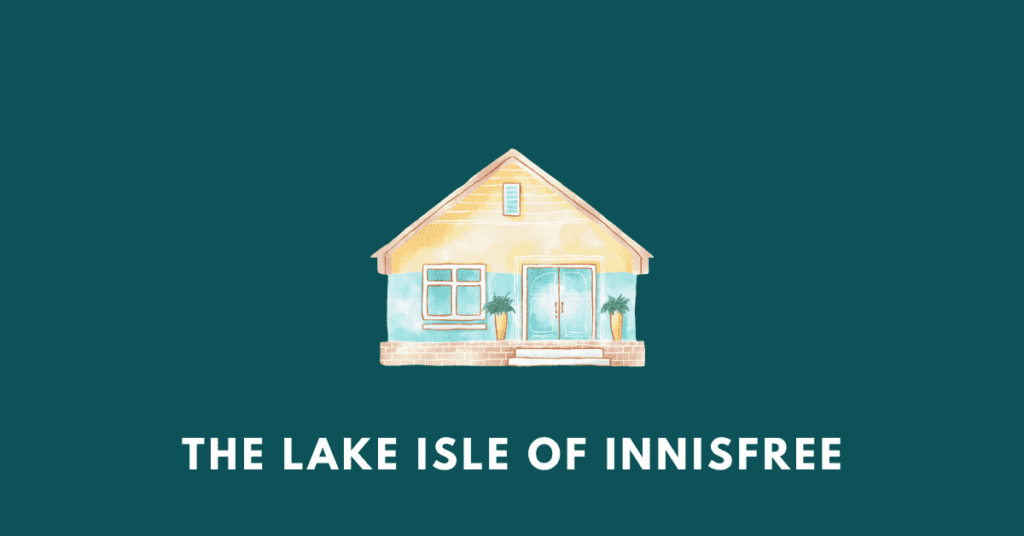Get here the summary, questions, answers, textbook solutions, extras, pdf of the poem The Lake Isle of Innisfree by W.B. Yeats of Assam Board (SEBA) and Tripura Board (TBSE) Class 9 English textbook (Beehive). However, the given notes/solutions should only be used for references and should be modified/changed according to needs.
Summary
William Butler Yeats’ poem “The Lake Isle of Innisfree” explores the poet’s inherent love of nature and his deep yearning to return to Innisfree, a place that holds the promise of peace and tranquillity for him. As an adult, the poet cannot help but reflect on his childhood memories, when, as a boy living in Innisfree, he was much closer to nature and, as a result, much happier. In this poem, the poet expresses man’s natural desire for peace in this poem.
In the first stanza, the poet expresses his desire to visit Innisfree right away. He fantasises about constructing a small cabin there, growing his own little garden of beans, and having a beehive, which would provide him with honey while also filling his glade with buzzing.
In the second stanza, we learn that the poet hopes to find peace at Innisfree. This peace will come with every element of nature, whether it is the morning mist, the daytime glowing sun, the evening sky covered by flights of linnets returning home, or the night sky glistening with stars.
Yeats repeats his determination to leave in the final stanza as if fueled by his memories, and he gives the reason that even though he lives in the city, even though he stands on the sidewalk in the midst of urban sounds, he hears the inviting sound of the lake water lapping at the shores of Innisfree.

Textual questions and answers
1. What kind of place is Innisfree? Think about:
(i) the three things the poet wants to do when he goes back there (stanza I)
(ii) what he hears and sees there and its effect on him (stanza II)
(iii) what he hears in his “heart’s core” even when he is far away from Innisfree (stanza III)
Answer: Innisfree is an ideal setting for a poet, full of beauty and peace and blessed by Nature. A place he longs to return to because it promises peace.
(i) When the poet returns to Innisfree, he desires to build a small cabin for himself out of clay and wattles, plant nine rows of beans, and have a hive for honeybees.
(ii)The poet hears and sees mists that appear to fall slowly from the sky, linnets flying back home at dusk, glowing and bright noon, and billions of twinkling stars that glimmer in the night sky. All of these have a profound effect on the poet, making him feel peaceful and arousing a strong desire to return to Innisfree without any delay, leaving behind his hectic urban life.
(iii) Even though he is miles away from Innisfree, the poet can hear the sound of the lake water lapping up against the shore in his heart. This is the sound he hears all day and night, and even when he stands by the roadside.
2. By now you may have concluded that Innisfree is a simple, natural place, full of beauty and peace. cHow does the poet contrast it with where he now stands? (Read stanza III)
Answer: The poet bestows many natural qualities on Innisfree, creating a vivid picture of
colour, happiness, beauty, and peace. In contrast, the use of the colour ‘grey’ to describe the pavement on which he now stands is sufficient to demonstrate that his current life is far from peaceful, melancholy, devoid of colour and that he receives nothing, not even peace in his life in the city.
3. Do you think Innisfree is only a place or a state of mind? Does the poet actually miss the place of boyhood days?
Answer: For the poet, Innisfree represents both a place of his childhood that he remembers for its natural beauty, and for the reader, the poet may have attempted to use Innisfree as a symbol of that state of mind where the poet can escape even while sitting in a place of disquiet. As a result, the poet speaks of “arise and go now,” implying that one can withdraw into one’s imagination and meditation at any time and find peace. The poet has fond memories of Innisfree, where he spent his childhood. He recalls the peace and calm he felt in this place in nature’s cradle, and he misses it terribly.
4. Look at the words the poet uses to describe what he sees and hears at Innisfree.
(i) bee-loud glade
(ii) evenings full of the linnet’s wings
(iii) lake water lapping with low sounds
What pictures do these words create in your mind?
Answer:
(i) bee-loud glade: A small clearing filled with the buzzing of bees.
(ii) evenings full of linnet wings: Tens of thousands of linnets flying back home as night falls.
(iii) lake water lapping with low sounds: The lake’s water slowly brushes against the shoreline as small waves form and disappear on its surface.
5. Look at these words;
…peace comes dropping slow
Dropping from the veils of the morning to where the cricket sings
What do these words mean to you?
Answer: These words paint the image of a serene and tranquil setting, free of pollution, where mist layers gradually descend as morning approaches.
What do you think “comes dropping slow… from the veils of the morning”?
Answer: I believe it means that the mist layers appear to be slowly descending as the night’s veil is lifted and the morning is revealed.
What does “to where the cricket sings” mean?
Answer: I believe it refers to the low levels of the ground, specifically the grass, where crickets are commonly found.
Additional/extra questions and answers/solutions
1. Where does the poet longs to go and why?
Answer: The poet longs to visit Innisfree, a tranquil and peaceful setting surrounded by nature.
18. What is the poet’s comparison between city life and life in the countryside?
Answer: Although the poet does not go into depth about city life, his desire to visit the beautiful island full of soothing sights and sounds indicates that he wishes to leave the noisy city life behind and live a simple existence. The contrast between bustling cities and Innisfree’s serene, natural surroundings validates his wish. On Innisfree, the description of lush glades and pastures, as well as birds and insects singing, contrasts with the drab-looking streets and pavements clogged with automobiles and people. This contrast alluded to the city’s noise pollution and congestion. Furthermore, the image of the island surrounded by the lake’s tranquil water and gentle waves is a lovely sight. People in cities, on the other hand, are engrossed in a race to amass material wealth. People who live close to nature have fewer needs, indicating greater contentment, as opposed to city dwellers’ never-ending pursuit of cash and material stuff. The poet’s desire to return to nature for a calm life alludes to the troubles and restlessness of city dwellers.

Ron’e Dutta is a journalist, teacher, aspiring novelist, and blogger. He manages Online Free Notes and reads Victorian literature. His favourite book is Wuthering Heights by Emily Bronte and he hopes to travel the world. Get in touch with him by sending him a friend request.
Get notes of other boards, classes, and subjects
